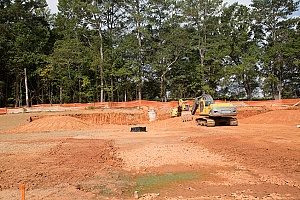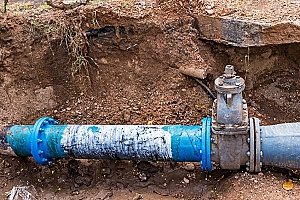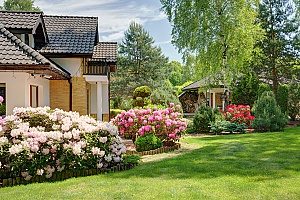 In terms of construction, land grading is a construction process in which land is leveled or sloped to form a base, typically called for when a foundation is needed for a building. Land grading can also be used to correct drainage problems, prevent flooding, level backyard space so the area is more useful, or terrace a property’s hillside yard.
In terms of construction, land grading is a construction process in which land is leveled or sloped to form a base, typically called for when a foundation is needed for a building. Land grading can also be used to correct drainage problems, prevent flooding, level backyard space so the area is more useful, or terrace a property’s hillside yard.
One of the most useful materials to use for land grading is fill dirt because its composition doesn’t contain any organic matter which would decompose over time and cause the dirt to shift. Land grading can be used to fix any storm drainage problems you may be experiencing with your yard, and it can be used to change the appearance of your yard for aesthetic purposes. If you are working on a land grading project, reach out to a fill dirt contractor to schedule your fill dirt delivery.
Why Is Fill Dirt Ideal For Storm Drainage?
The two big types of dirt that most people choose for their projects are fill dirt and topsoil. Both have very different compositions and therefore have very different uses. Topsoil is essential for gardening or farming because this type of nutrient-rich dirt helps plants thrive. However, if fill dirt is used for a farming project, plants would have a very difficult time growing because fill dirt lacks the necessary nutrients. Fill dirt is primarily used for construction purposes such as building foundations or land grading.
If topsoil is used for foundations or land grading, the project won’t be successful because topsoil contains organic matter that breaks down over time. This will result in the volume of the topsoil changing, which could then potentially cause any foundations on top to shift. This is also a problem when it comes to land grading because if you are trying to fill a low point, the low point may be initially filled to be level with the rest of the land, but over time the changing volume of the topsoil will result in the low point returning.
How To Correct Drainage Problems and Preventing Flooding
Unwanted water that is collecting in your yard can actually cause serious problems if it is not properly taken care of. It can damage the plants in your backyard, become a breeding ground for mosquitoes, create an unusable environment until the water dries out, and the excess water can cause problems for your house’s foundation since it can slip into the walls and cause problems such as cracks and mold.
Find The Highest And Lowest Points
 To fix this problem you have to find the high point and the low point of your drainage problem. The high point is where the water is flowing in the wrong direction. For example, if the land slopes down in the direction of your house, the high point is going to be the very top of the slope. The low point is where the water is pooling, so it would be the very bottom of the slope. If your yard is relatively flat, it may be hard for you to determine these spots right away.
To fix this problem you have to find the high point and the low point of your drainage problem. The high point is where the water is flowing in the wrong direction. For example, if the land slopes down in the direction of your house, the high point is going to be the very top of the slope. The low point is where the water is pooling, so it would be the very bottom of the slope. If your yard is relatively flat, it may be hard for you to determine these spots right away.
Survey The Buildup Of Water
Wait for a rainstorm that creates water flow in your yard. When the rainstorm is over, walk around your yard and take note of where the water is pooling. This can be done sticking a stake or other marker into the ground. Wait an hour and then check the points you have marked again. If the standing water is still there, then this is a low point in your yard where the water is draining to.
To fix this problem you need to place enough fill dirt in the low point to make it level with the high point. The fill dirt that has been placed will change the level of the slope and prevent water from pooling where you don’t want it to.
Build A Swale To Divert The Water
You could also build a swale to move the water from its unwanted location. A swale is a shallow trench that is dug out completely level along the land’s contour with a berm on the downhill side. Swales are great if you’re looking to make your yard earth-friendly because they help to not overwhelm the sewer systems. This is because they slow, store and spread stormwater. If you are a gardener, you could even construct it to have the water flow into rain barrels which will allow you to water your plants during dry spells.
When constructing a swale, it’s important to remember that the goal of managing rainwater is to hold it as high in the landscape as possible. This will create maximum efficiency and absorption. The swale will catch the water and prevent it from reaching your house by redirecting it, and by absorbing it deep into the soil. Building a swale is relatively simple and only requires some fill dirt to help you. Once you’ve selected the ideal location for your swale, dig out a trench in the direction you want to the water to run. Then using fill dirt, build up one side of the swale to create a berm that will prevent the water from escaping the swale.
Speak With Dirt Connections For More Information
 Land grading doesn’t just have to serve practical purposes, you can also use it to redesign your backyard to either make it more useful, or to achieve your desired look. This is done by taking fill dirt and placing in specific locations to change up your landscape. If you’re looking to make your landscape level, the fill dirt will be placed in any low points to make them even with the rest of the land. If you’re looking to create more of a hilly terrain aesthetic, fill dirt can be placed in areas you wish to build up higher. Placing the fill dirt is relatively simple, you just have to pack down the dirt after to ensure that it won’t move anywhere you don’t want it to. Using fill dirt for land grading will allow you to create the backyard you’ve always dreamed of. Reach out to a fill dirt contractor for more information about fill dirt and its uses and to schedule your fill dirt delivery.
Land grading doesn’t just have to serve practical purposes, you can also use it to redesign your backyard to either make it more useful, or to achieve your desired look. This is done by taking fill dirt and placing in specific locations to change up your landscape. If you’re looking to make your landscape level, the fill dirt will be placed in any low points to make them even with the rest of the land. If you’re looking to create more of a hilly terrain aesthetic, fill dirt can be placed in areas you wish to build up higher. Placing the fill dirt is relatively simple, you just have to pack down the dirt after to ensure that it won’t move anywhere you don’t want it to. Using fill dirt for land grading will allow you to create the backyard you’ve always dreamed of. Reach out to a fill dirt contractor for more information about fill dirt and its uses and to schedule your fill dirt delivery.








































